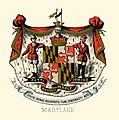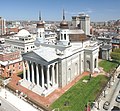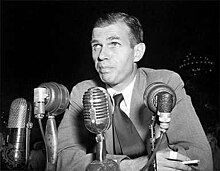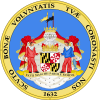Portal:Maryland
|
Maryland Portal
|
Baltimore Task Force
|
Frederick Task Force
|
Montgomery Task Force
|
WikiProject Maryland
|
|
Main page
|
Discussion
|
Introduction Maryland (US: /ˈmɛrɪlənd/ ⓘ MERR-il-ənd) is a state in the Mid-Atlantic region of the United States. The state borders Virginia to its south, West Virginia to its west, Pennsylvania to its north, Delaware to its east, the Atlantic Ocean, and the national capital of Washington, D.C. With a total area of 12,407 square miles (32,130 km2), Maryland is the ninth-smallest state by land area, and its population of 6,177,224 ranks it the 18th-most populous state and the fifth-most densely populated. Maryland's capital is Annapolis, and the most populous city is Baltimore. Occasional nicknames include Old Line State, the Free State, and the Chesapeake Bay State. It is named after Henrietta Maria, the French-born queen of England, Scotland, and Ireland during the 17th century. The western portion of the state contains numerous stretches of the Appalachian Mountains, the central portion is primarily composed of the Piedmont, and the eastern side of the state makes up a significant portion of Chesapeake Bay. Maryland's coastline was first explored by Europeans in the 16th century. Prior to that, it was inhabited by several Native American tribes, mostly the Algonquian peoples and, to a lesser degree, Iroquoians and Siouans. As one of the original Thirteen Colonies of England, Maryland was founded by George Calvert, 1st Baron Baltimore, a Catholic convert who sought to provide a religious haven for Catholics persecuted in England. In 1632, Charles I of England granted Lord Baltimore a colonial charter, naming the colony after his wife, Henrietta Maria. Unlike the Pilgrims and Puritans, who rejected Catholicism in their settlements, Lord Baltimore envisioned a colony where people of different religious sects would coexist under the principle of toleration. (Full article...) This is a Featured article, which represents some of the best content on English Wikipedia..
George Calvert, 1st Baron Baltimore (/ˈbɔːltɪmɔːr/; 1580 – 15 April 1632) was an English peer and politician. He achieved domestic political success as a member of parliament and later Secretary of State under King James I. He lost much of his political power after his support for a failed marriage alliance between Prince Charles and the Spanish House of Habsburg royal family. Rather than continue in politics, he resigned all of his political offices in 1625 except for his position on the Privy Council and declared his Catholicism publicly. He was created Baron Baltimore in the Peerage of Ireland upon his resignation. Baltimore Manor was located in County Longford, Ireland. Calvert took an interest in the British colonization of the Americas, at first for commercial reasons and later to create a refuge for persecuted Irish and English Catholics. He became the proprietor of Avalon, the first sustained English settlement on the southeastern peninsula on the island of Newfoundland (off the eastern coast of modern Canada). Discouraged by its cold and sometimes inhospitable climate and the sufferings of the settlers, he looked for a more suitable spot further south and sought a new royal charter to settle the region, which would become the state of Maryland. Calvert died five weeks before the new Charter was sealed, leaving the settlement of the Maryland colony to his son Cecil (1605–1675). His second son Leonard Calvert (1606–1647) was the first colonial governor of the Province of Maryland. (Full article...)General imagesIn the news
On this day...This is a Good article, an article that meets a core set of high editorial standards.
The 1999 Baltimore Orioles – Cuba national baseball team exhibition series consisted of two exhibition games played between the Baltimore Orioles of Major League Baseball (MLB) and the Cuba national baseball team on March 28 and May 3, 1999. The first game took place in Havana, while the second was held in Baltimore. This series marked the first time that the Cuba national team had faced a squad composed solely of major league players and the close of the hiatus since 1959 that an MLB team played in Cuba. In the 1990s, Orioles' owner Peter Angelos lobbied the United States federal government to gain permission to hold this series for three years. Various politicians, including members of the United States House of Representatives, opposed the idea and attempted to block the series. Eventually, Angelos secured the approval in 1999, after a change in United States foreign policy to Cuba under President Bill Clinton, which eased travel restrictions and increased cultural exchange. (Full article...)Selected article -Alger Hiss (November 11, 1904 – November 15, 1996) was an American government official accused in 1948 of having spied for the Soviet Union in the 1930s. The statute of limitations had expired for espionage, but he was convicted of perjury in connection with this charge in 1950. Before the trial Hiss was involved in the establishment of the United Nations, both as a US State Department official and as a UN official. In later life, he worked as a lecturer and author. On August 3, 1948, Whittaker Chambers, a former US Communist Party member, testified under subpoena before the House Un-American Activities Committee (HUAC) that Hiss had secretly been a communist while in federal service. Hiss categorically denied the charge and subsequently sued Chambers for libel. During the pretrial discovery process of the libel case, Chambers produced new evidence allegedly indicating that he and Hiss had been involved in espionage. A federal grand jury indicted Hiss on two counts of perjury. After a mistrial due to a hung jury, Hiss was tried a second time, and in January 1950 he was found guilty and received two concurrent five-year sentences, of which he eventually served three and a half years. (Full article...)Did you know?

SubcategoriesSelect [+] to view subcategories
TopicsRelated portalsAssociated WikimediaThe following Wikimedia Foundation sister projects provide more on this subject:
Discover Wikipedia using portals |

























































